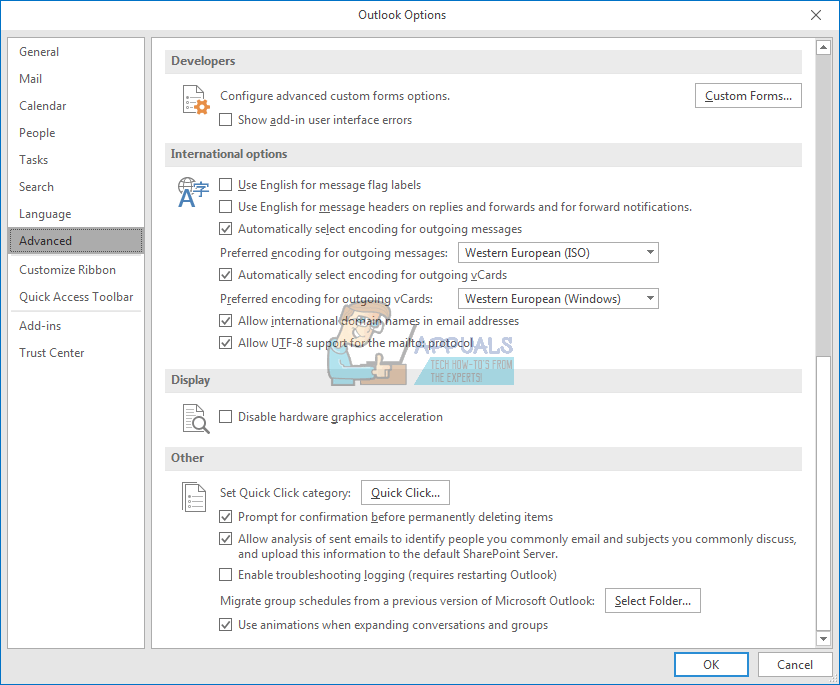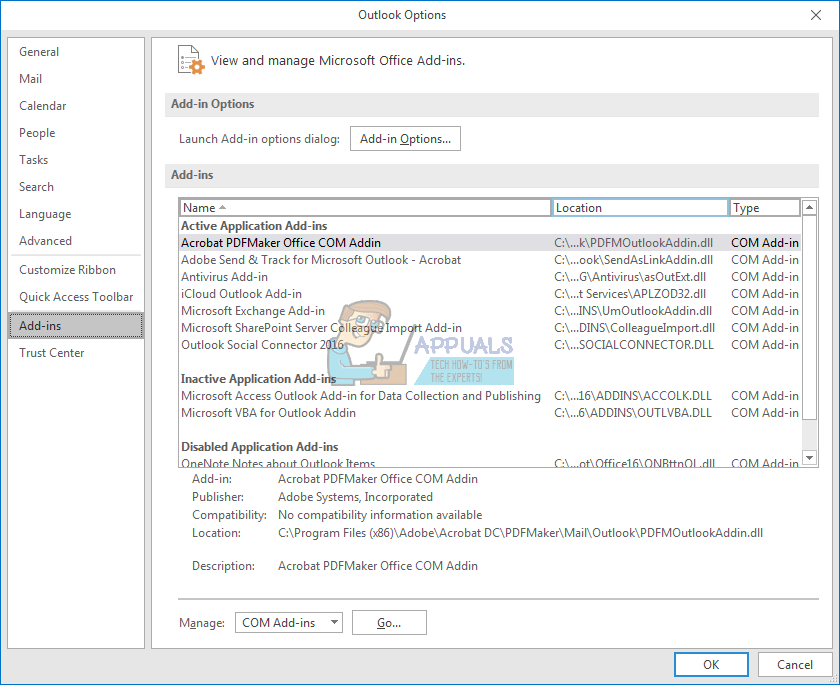Fix: Outlook 2016 Slow on Windows 10
Web email services have been very popular and quite helpful for those that travel a lot. However, without a messenger application for these emails, you cannot get real-time notifications of received emails. Most service providers provide a link for your mails through desktop applications like Windows Live Mail and Microsoft Outlook. Outlook is an email app that comes with Microsoft Office. This means you can get your web emails directly to your PC by using the IMAP (Internet Message Access Protocol) or POP (Post Office Protocol) configurations. By downloading the messages to your device, you can be able to view and send/forward them by use of the syncing mechanism.
However, it is not always a smooth experience. Some users might find that their MS Outlook becomes sluggish and freezes up the computer. The program will take several minutes to open, and when it does, opening a message is just as slow. Syncing to the server also seems to take forever. Because of this, sending a message is really slow. Receiving a message is also painfully slow since the application can’t seem to complete syncing. This article will explain to you why the Microsoft Outlook application can become so slow, and how you can fix such a problem.
Why Outlook is slow
There are several reasons why Outlook 2016 might be slow.
- The first reason is really simple. The connection to the server cannot be completed. If you are sure that your email provider has no problem in their end, then there is a possibility that you changed your email password. This is especially common for emails that can be accessed through a web browser. By changing the password, Outlook will no longer be able to reach the service provider or the email servers. In an attempt to establish a connection, it sends the ‘wrong’ password over and over, eventually slowing the app and the PC. This also means that you will not be able to receive or send emails.
- The second reason is the hardware acceleration feature. This is quite common if in your case, you are able to receive or send mail after a long wait. Hardware acceleration is a technique in which a computer’s hardware is forced to perform faster than usual. This technique is used with computing tasks that require more power and processing, such as graphics or video processing. Unfortunately, using the hardware graphics acceleration feature can sometimes slow down a program or your computer in general. If this happens, it’s best to turn off the feature to get your computer running normally.
- Another reason would be the use of add-ins on the Outlook program. These are a bunch of tools and utilities within the Outlook app like the calendar, Evernote, weather, Uber reminder, Paypal, email scanners from your antivirus software, task managers among others. While these tools might be useful, they might slow down your Outlook application if they are too many, or if they conflict with Outlook. A good example would be the email scan tool. If you decide to switch to another antivirus software or you turn of web protection on your antivirus, the add-in on Outlook will try severally to communicate with the missing or outdated antivirus in vain, hence slowing down and freezing Outlook and the PC.
- There is also a good possibility that your database might be corrupt or it has exceeded the limit capacity. This slows and freezes the app in an attempt to read the database.
Troubleshooting Outlook
To troubleshoot Outlook, we will try opening it in safe mode. In safe mode, only the necessary components needed for your mail will be loaded. This excludes add-ins. To do that, close Outlook. Press Windows + R to open Run, and in the open box type in ‘Outlook /safe’ and hit ok.

If the application works fine in safe mode, then the add-ins are likely to be the problem. Otherwise your issue might be caused by a bad password, hardware acceleration or a bad database. Below are the solutions to these causes. Note that this might work on other versions of outlook too e.g. Outlook 2013 or 2010.
Method 1: Disable hardware acceleration on outlook
This will limit the percentage of CPU used by Outlook and bring it back to normal. To disable hardware acceleration on outlook:
- Open Outlook
- Click on File > Options
- In the Options dialog box, click ‘Advanced’ on the left-hand-side panel.
- Scroll down to the display section.
- In the list of available options, click to select the Disable hardware graphics acceleration check box (make sure it is ticked/checked).

- Click OK and restart Outlook and see if the problem is fixed.
Method 2: Disable Outlook add-ins
Disabling add-ins will save on the power and memory needed to run the Outlook add-ins.
- Open Outlook
- Click on File > Options
- In the Options dialog box, click ‘Add-ins’ on the left-hand-side panel

- In the Manage dropdown box section, select ‘COM Add-ins’ and click on Go.
- Now uncheck the Add-ins and click on OK. Some of the known offending add-ins includes the social connector, Social Media add-in, business connectivity add-in, Nuance PDF Outlook Add-in, Skype add-in, and outdated antivirus add-ins (Especially AVG).

Method 3: Repair the Outlook .PST file
If your Outlook program seems to have developed the issue suddenly, especially after a blackout, then your data might be corrupt and in need of cleaning. The outlook .pst file holds profile information and email data and this is what needs to be repaired. By default, a Microsoft Outlook PST file is located in the document folder for Outlook 2010, 2013 and 2016. Microsoft Office comes with a tool named ‘Scanpst.exe’ in the office folder. This tool can be used to repair your .pst file. To repair the file:
- Close Outlook
- Locate the ‘scanpst.exe file’ in your computer program files. Here is the directory for the 2016 office/outlook:
Outlook 2016
32-bit Windows; C:\Program Files\Microsoft Office\Office16\
64-bit Windows; C:\Program Files (x86)\Microsoft Office\Office16\
64-bit Outlook; C:\Program Files\Microsoft Office\Office16\
The locations are pretty similar for other versions of Outlook.
- Right click the SCANPST.EXE file and select “run as administrator” to launch it
- In the Microsoft Outlook Inbox Repair Tool that appears, click on browse and locate your .pst file. This is the location for your .pst Outlook 2016 file (same for 2010 and 2013) (make a backup of the .pst file before you continue):
C:\Users\%username%\Documents\Outlook Files\ - Select your .pst file and click ‘open’
- After you have selected the pst-file to scan, press the Start button. Nothing will happen to your pst-file yet; scanpst will do an analysis first. This consists of 8 phases some of which can take a bit long to complete than others depending on the size and level of corruption of the file.
- You will be presented with a report at the end of the scan. You can click on ‘Details’ for more information about the errors. Check the “make backup of scanned file before repairing” checkbox if you had not backed up your file yet.
- Click on ‘Repair’ to begin the repair process. The process will start and go through the 8 phases again. With a slow hard disk and a large file of over 4 GB, this process can take upto 30 minutes. The tool might freeze during the repair process (shows ‘Not responding’ on the title bar) so don’t be alarmed.
- If the process completes successfully, you will get a message box saying “Repair Complete.” Click OK and open Outlook.
Also refer to this article previously written specifically focusing on repairing corrupted pst and ost files: Repair Corrupt PST or OST files
Method 4: Update your password
A wrong password might cause the application to freeze. This is the case if you had changed your email password with your email service provider. To update your password in Outlook 2016:
- Open Outlook
- Click on file, and click on the info tab.
- Click on ‘Account Settings’ and from the submenu that appears, click on ‘Account Settings’
- Select the email account you want to update the password for and click ‘Change’
- In the Change Account window, update your password. Tip: in this page, you can also set the number of months for which to keep offline mails. Reducing the months will make your .pst file smaller which will maker Outlook faster.
- Click ‘Next’ to test your account settings
- Choose Close after Outlook tests your account settings, then Finish > Close to return to Outlook.